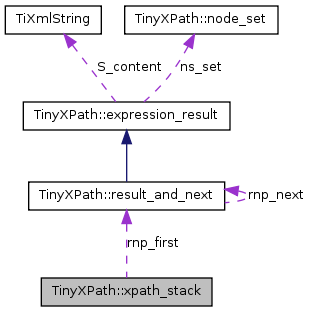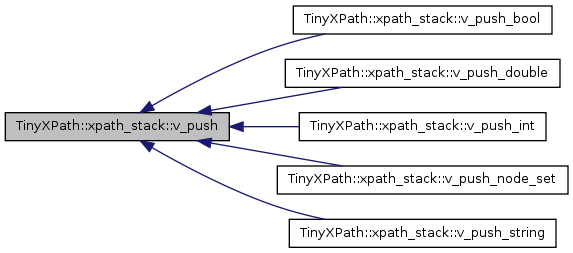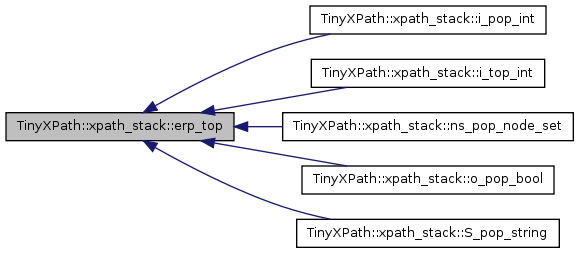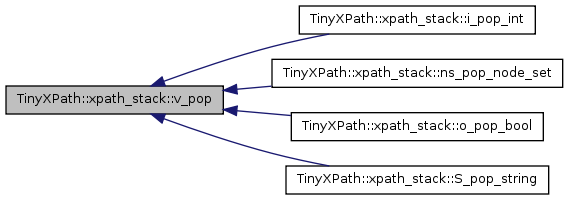#include <xpath_stack.h>

Public Member Functions
- xpath_stack ()
- ~xpath_stack ()
- void v_push (expression_result er_res)
- void v_push_int (int i_elem, const char *cp_comment=NULL)
- void v_push_bool (bool o_in)
- void v_push_string (TiXmlString S_in)
- void v_push_double (double d_elem)
- void v_push_node_set (node_set *nsp_ptr)
- Push a node_set on the stack.
- Push a node_set on the stack.
- expression_result * erp_top ()
- int i_top_int ()
- void v_pop (unsigned u_nb=1)
- int i_pop_int ()
- TiXmlString S_pop_string ()
- bool o_pop_bool ()
- node_set ns_pop_node_set ()
- Pops the top node_set from the stack.
- Pops the top node_set from the stack.
- unsigned u_get_size ()
- expression_result * erp_previous (unsigned u_nb)
Protected Member Functions
- void v_pop_one ()
Protected Attributes
- result_and_next * rnp_first
- unsigned u_size
Detailed Description
The XPath execution stack
All elements are result_and_next elements
Constructor & Destructor Documentation
| TinyXPath::xpath_stack::~xpath_stack | ( | ) |
Member Function Documentation
| void TinyXPath::xpath_stack::v_push | ( | expression_result | er_res | ) |
Push a new element on the stack.
References rnp_first, and u_size.
Referenced by v_push_bool(), v_push_double(), v_push_int(), v_push_node_set(), and v_push_string().

| void TinyXPath::xpath_stack::v_push_int | ( | int | i_elem, | |
| const char * | cp_comment = NULL | |||
| ) |
| void TinyXPath::xpath_stack::v_push_bool | ( | bool | o_in | ) |
| void TinyXPath::xpath_stack::v_push_string | ( | TiXmlString | S_in | ) |
| void TinyXPath::xpath_stack::v_push_double | ( | double | d_elem | ) |
| void TinyXPath::xpath_stack::v_push_node_set | ( | node_set * | nsp_ptr | ) |
| expression_result * TinyXPath::xpath_stack::erp_top | ( | ) |
Retrieve top expression from the stack.
References rnp_first.
Referenced by i_pop_int(), i_top_int(), ns_pop_node_set(), o_pop_bool(), and S_pop_string().

| int TinyXPath::xpath_stack::i_top_int | ( | ) |
| void TinyXPath::xpath_stack::v_pop | ( | unsigned | u_nb = 1 |
) |
Pop N element from the stack.
References v_pop_one().
Referenced by i_pop_int(), ns_pop_node_set(), o_pop_bool(), and S_pop_string().


| int TinyXPath::xpath_stack::i_pop_int | ( | ) |
| TiXmlString TinyXPath::xpath_stack::S_pop_string | ( | ) |
Pops the top string from the stack.
References erp_top(), TIXML_STRING, and v_pop().

| bool TinyXPath::xpath_stack::o_pop_bool | ( | ) |
| node_set TinyXPath::xpath_stack::ns_pop_node_set | ( | ) |
| unsigned TinyXPath::xpath_stack::u_get_size | ( | ) | [inline] |
Return the stack's size.
References u_size.
| expression_result * TinyXPath::xpath_stack::erp_previous | ( | unsigned | u_nb | ) |
| void TinyXPath::xpath_stack::v_pop_one | ( | ) | [protected] |
Pop one element from the stack.
References rnp_first, and u_size.
Referenced by v_pop(), and ~xpath_stack().

Member Data Documentation
result_and_next* TinyXPath::xpath_stack::rnp_first [protected] |
First element in the stack.
Referenced by erp_previous(), erp_top(), v_pop_one(), v_push(), xpath_stack(), and ~xpath_stack().
unsigned TinyXPath::xpath_stack::u_size [protected] |
Stack size.
Referenced by erp_previous(), u_get_size(), v_pop_one(), v_push(), and xpath_stack().
The documentation for this class was generated from the following files:










 1.7.1
1.7.1